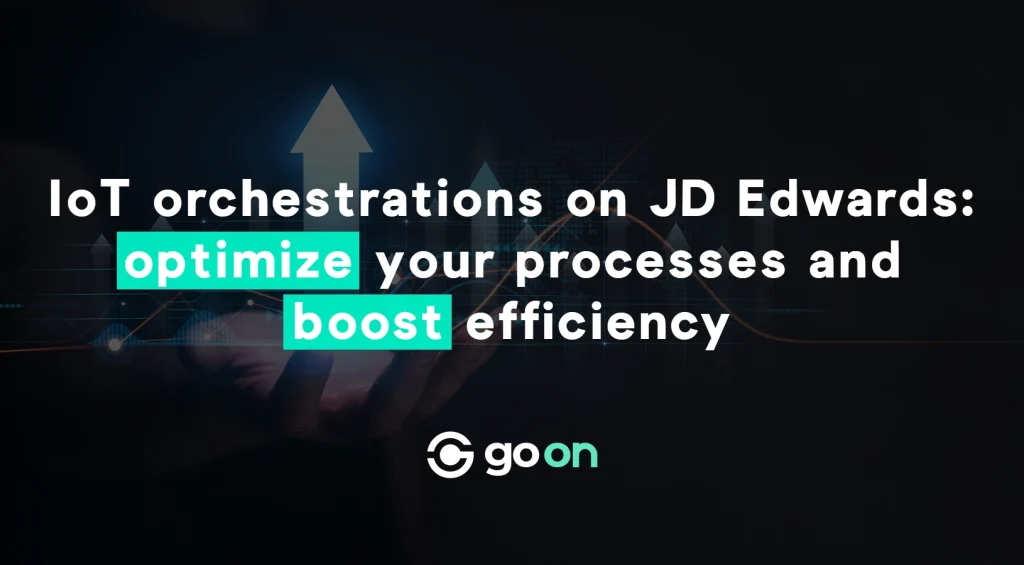Turning data into smart actions with IoT and Go On orchestrations
Integrating IoT devices with JD Edwards EnterpriseOne requires effective management of the data they generate. JD Edwards Orchestrator is an essential tool for this process, as it facilitates the transformation and use of data from connected devices. Let’s examine how orchestrations can optimize each aspect of integration:
1. Acceptance criteria
Acceptance criteria are key to ensuring that only validated data and devices are incorporated into the system.
In the context of IoT, this means that every piece of data collected and transmitted by sensors and connected devices must meet specific standards in order to be accepted and processed by JD Edwards.
These criteria ensure data integrity and security, avoiding problems such as corrupted or falsified data.
How do the acceptance criteria work?
- Data validation: checks that data meets predefined requirements before it is accepted by the system.
- Security and integrity: protects against unwanted or potentially harmful data entries, ensuring that only reliable information is processed.
- Device filtering: ensures that only authorized and properly configured devices interact with the system.
2. Mapping
Mappings are processes that translate data from external devices into formats compatible with JD Edwards EnterpriseOne. They are essential to ensure that information collected by sensors or other devices is correctly integrated and used in the ERP system.
How do mappings facilitate integration?
- Data conversion: transforms data from different formats and protocols into a standard compatible with JD Edwards.
- Transfer accuracy: ensures that data is placed in the correct fields within the system, avoiding errors and inconsistencies.
- Efficient integration: optimizes the flow of information, enabling faster and more accurate data integration.
3. Rules of action
Action rules determine when and how incoming data should be processed and used by JD Edwards. These rules are essential for optimizing business processes, ensuring that the appropriate actions are taken based on the data received.
How do rules of action improve processes?
- Process automation: defines automatic actions based on specific conditions, such as generating alerts or initiating processes within the ERP.
- Operational efficiency: reduces the need for manual intervention, speeding up the execution of business processes.
4. Stages of the integration process
The integration process steps transform IoT data into actionable transactions within JD Edwards EnterpriseOne. This process is vital for converting raw information into practical actions that can improve business operations and decision-making.
How do the stages of the integration process transform data?
- Data transformation: converts collected data into transactions and records that can be used for decision-making and operations.
- Automation of Operations: allows processes to be carried out automatically based on data collected in real time, such as updating inventory or issuing work orders.
- Improved decision-making: provides insights and reports based on up-to-date data, improving analysis and decision-making capacity.
Benefits of IoT integration with JD Edwards
Integrating IoT devices with JD Edwards EnterpriseOne through orchestrations offers a number of significant benefits:
1. Increased operational efficiency
By automating data collection and processing, Orchestrator reduces the need for manual and repetitive tasks. This frees up employees to focus on more value-added activities, increasing productivity and overall efficiency.
2. Data security
With strict acceptance criteria and data validation, Orchestrator ensures that only reliable information is integrated into the system. This improves data security and protects against possible threats and errors.
3. Efficient integration
Through precise mappings and well-defined action rules, Orchestrator facilitates integration between external devices and JD Edwards EnterpriseOne. This ensures that data is used effectively, improving the consistency and accuracy of information.
4. Rapid response to change
With the ability to process data in real time and adjust processes automatically, Orchestrator allows your company to respond quickly to market changes and customer needs, giving you a significant competitive advantage.
5. Cost reduction
By automating processes and eliminating the need for manual interventions, Orchestrator helps to reduce operating costs. This minimizes errors and rework, resulting in significant savings for the company.
To find out more about how IoT orchestrations on JD Edwards can transform your operation and boost the efficiency and security of your business processes, contact one of our consultants by WhatsApp: 41 98739-6726.
We are here to help your company make the most of digital solutions and reach new heights of success.
Go On is committed to offering customized solutions that meet your company’s specific needs. Discover how our solutions can make a difference and drive digital transformation in your business.

